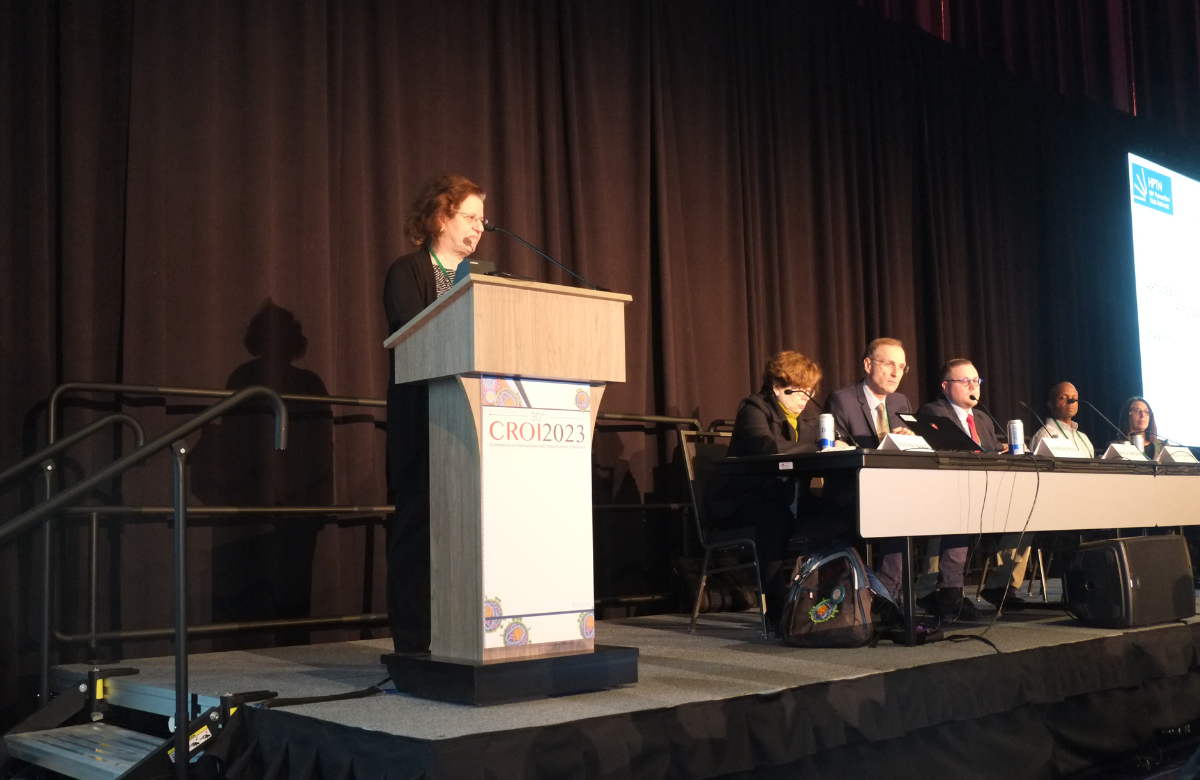Having problems reading this email? View it in your browser >>
|
||
 |
||
|
||
Contents
|
||
Promising new PrEP method undergoes first safety study for anal sex | ||
 Dr Sharon Riddler at CROI 2023. Photo by Roger Pebody. | ||
|
The findings were presented at the 30th Conference on Retroviruses and Opportunistic Infections (CROI 2023) in Seattle, US, last week. The insert contains 60mg elvitegravir and 20mg tenofovir alafenamide (TAF) and is designed to be inserted in the vagina or rectum, where it dissolves within a few hours. It is about 1.5cm long and less than 1cm wide. Researchers assessed the safety and pharmacokinetics (drug levels) of a single insert in the 72 hours after rectal insertion. The study was then repeated using two inserts. Twenty-three HIV-negative people (17 men and 6 women) took part, with 21 having the single dose and 19 the double dose. Drug levels were measured in blood, rectal fluid, cervicovaginal fluid (if applicable) and rectal tissue samples, and also the levels of tenofovir diphosphate (TFV-dp) – the active substance TAF turns into once it enters a cell – inside rectal tissue cells. Protective drug levels were maintained for over a day and, in the case of tenofovir, for over three days. TAF levels declined in blood but TFV-dp levels scarcely changed. Only one grade 2 drug-related side effect was seen: mild anal inflammation, which soon resolved. This is the first human safety study of rectal use of the insert. Data from a study of vaginal use of the insert presented in 2021 found similar results. | ||
Lenacapavir plus broadly neutralising antibodies may offer twice-yearly treatment option | ||
 Professor Joseph Eron at CROI 2023. Photo by Andy Carstens. | ||
|
Professor Joseph Eron of the University of North Carolina at Chapel Hill reported that 90% of study participants who received injections of lenacapavir plus infusions of the bnAbs teropavimab and zinlirvimab maintained an undetectable viral load six months after stopping their existing antiretroviral therapy. Lenacapavir is an HIV capsid inhibitor and, because it works differently to other HIV medications, it remains active against virus that has developed resistance to other antiretroviral classes. In 2022, it was approved in the US and Europe for treatment-experienced people with multidrug-resistant HIV. Its long half-life means it can be taken just twice a year, but currently there are no other antiretrovirals that can be given at such a long interval. Eron and colleagues evaluated a regimen of lenacapavir and two bnAbs administered every six months. The trial enrolled 21 people with HIV who were on antiretroviral therapy with viral suppression for at least 18 months. They were tested to ensure that their HIV was sensitive to both antibodies (half the potential participants were not eligible because of resistance). Participants received two oral loading doses of lenacapavir, two subcutaneous injections of lenacapavir and an intravenous infusion of teropavimab (30mg/kg). In addition, they were randomly assigned to receive either 10mg/kg or 30mg/kg of zinlirvimab. At 26 weeks, lenacapavir, teropavimab and zinlirvimab (using either dose) remained well above therapeutic levels and 90% of participants in both groups maintained viral suppression. One person in the higher-dose group decided they preferred pills and withdrew from the study. One person in the lower-dose group experienced viral rebound and resumed their baseline regimen. CD4 counts remained stable in both groups. Treatment was safe and generally well tolerated. A phase II clinical trial will start this year to see whether viral suppression can be maintained when the regimen is continued for a longer time with multiple twice-yearly doses. | ||
Huge increase in PrEP uptake when services offer choice and flexibility | ||
 Dr Elijah Kakande (third from left) at CROI 2023. Photo by Roger Pebody. | ||
|
A dynamic, person-centred HIV prevention intervention resulted in substantial increases in the numbers of people covered by PrEP or PEP in rural Uganda and Kenya, researchers told CROI 2023. Three separate randomised controlled trials conducted using village health teams, in antenatal clinics and in hospital outpatient departments each showed the benefit of this model of care. The researchers conducted qualitative work to identify barriers to the uptake of HIV prevention and design their intervention, which was then compared to the care that was routinely available. The model of care included elements such as: giving people a choice of prevention product, service location and ways to take an HIV test; providing three months of PrEP or starter packs of PEP; and having clinicians available by phone every day. Outcomes were assessed in around 400 people in each setting and the impact of the intervention was evaluated by measuring biomedical HIV prevention coverage – the proportion of time that people said they were using PEP or PrEP during almost a year of follow-up. In the village study, in which health workers went door to door, PrEP or PEP was used for 0.5% of the time in the standard-of-care arm and 28% of the time in the intervention arm. In the antenatal clinics, coverage was 29% and 70%, respectively, and in outpatient departments, 18% and 48%. In all three studies an increasing number of people chose self-testing as time went on. Similarly, in the last two studies, the number getting their care in community settings increased during follow-up, whereas in the village study, almost everyone received services at home throughout. | ||
HIV infections acquired on injectable PrEP may not be identified for a long time | ||
 Dr Susan Eshleman presenting at CROI 2023. Photo by Roger Pebody. | ||
|
The most recent data from the HPTN 083 study of injectable cabotegravir in gay and bisexual men and transgender women show six people (less than 0.3%) have acquired HIV despite having apparently adequate drug levels. A key problem with these infections is establishing whether they have happened. Eshleman gave as an example a participant in HPTN 083. In the 48 weeks following a first positive result, he had 54 tests using 6 different types of assays, but only 15 tests yielded a positive result. Dubbing this syndrome long-acting early viral inhibition (LEVI), Eshleman asked how it should be dealt with clinically. In these circumstances, people may not feel unwell, their CD4 counts remain high, and their viral loads are far too low to be infectious. However, the development of drug resistance in LEVI cases is common. Integrase inhibitor resistance arose in 10 of the 18 cases in HPTN 083 where the gap between the last injection and HIV infection was less than six months. Recommending RNA tests as standard with injectable PrEP would be one solution. However, LEVI is rare and RNA tests are expensive. Eshleman said that RNA tests would be introduced for the rest of the open-label phase of the HPTN 083 and 084 studies of injectable PrEP, in order to provide data on whether the tests had a useful role to play. | ||
Experimental islatravir implants protect monkeys against HIV-like virus | ||
 Professor Alessandro Grattoni at CROI 2023. Photo by Roger Pebody. | ||
|
One group of researchers tested a refillable implant that could last for several years, while another team evaluated a biodegradable implant. Both implants protected female macaque monkeys against vaginal infection with SHIV – a hybrid simian-human virus similar to HIV – and the refillable implant also protected male monkeys against rectal infection. The refillable implant is designed to be inserted under the skin, for example on the inside of the upper arm. To refill it, one needle is inserted through the skin to fill the first port in the implant while another needle is used to withdraw excess fluid from a second port. Professor Alessandro Grattoni of Houston Methodist Research Institute in Texas and colleagues conducted a pharmacokinetic study, in which implants were inserted under the skin on monkeys’ backs and drug concentrations were measured over time. Drug levels above those needed for protection as PrEP were maintained for more than 20 months. Next, the researchers repeatedly exposed the animals to low-dose SHIV. Six male monkeys received 10 once-weekly rectal exposures and six females received 10 vaginal exposures. None of the monkeys with islatravir implants acquired SHIV, while all the monkeys in the control group did. In a second study, Dr Michele Daly of the US Centers for Disease Control and Prevention and colleagues evaluated islatravir implants made of polycaprolactone, a biodegradable polymer. Daly noted that islatravir could potentially be combined with contraceptives in the same implant. Six female macaques received two implants, under the skin of each upper arm. After five weeks of pharmacokinetic monitoring, they were vaginally exposed to SHIV twice weekly for six weeks. One implant was removed and they were monitored for another five weeks, then repeatedly exposed to SHIV again. While they had two implants, none of the six monkeys acquired SHIV after 12 exposures. After one implant was removed, one of the six animals acquired SHIV. However, the fate of islatravir remains unclear, following declines in total lymphocyte counts and CD4 T-cell counts seen in some study participants. The manufacturer Merck has started treatment trials using a lower oral dose of islatravir and is considering its options in relation to implants. | ||
Other CROI 2023 headlines | ||
White blood cell changes on islatravir do not lead to higher risk of infectionsDeclines in white blood cell counts in people taking the experimental HIV drug islatravir are not associated with higher rates of infections, and the combination of doravirine and islatravir is just as effective as existing treatment in maintaining viral suppression. HIV regimens containing TAF and cobicistat linked to physical depression symptoms in womenWomen with HIV taking antiretroviral combinations containing tenofovir alafenamide (TAF) and a cobicistat-boosted protease inhibitor or integrase inhibitor were more likely to experience numerous physical symptoms of depression than women taking other antiretroviral regimens, the Women’s Interagency HIV Study reported. Weight loss after treatment switch more likely for those with higher body massWeight loss after switching from tenofovir alafenamide (TAF) and an integrase inhibitor appears more likely in people with a body mass index (BMI) of 30 or above, two European studies suggest. Failure of integrase inhibitor-based regimens may be due to a completely novel form of resistanceHigh-level resistance to the integrase inhibitor family of drugs may arise in a completely different way to what’s been seen in other types of resistance. Integrase inhibitors can lose efficacy not due to mutations arising in the drug target, the integrase enzyme, but due to mutations in its envelope protein. Tenofovir disoproxil-based pill regains its position as first choice for PrEP in the USMore than half the people taking HIV PrEP in the US are now taking a generic pill containing tenofovir disoproxil fumarate (TDF) and emtricitabine (FTC), a poster revealed. In the last year, an apparent trend to replace TDF/FTC with the tenofovir alafenamide/emtricitabine pill branded as Descovy has reversed. | ||
Connect with us |
||
|
NAM's news coverage of CROI 2023 has been made possible thanks to support from ViiV Healthcare. |
||
|
aidsmap is an award-winning, community-based organisation, which works from the UK. We deliver reliable and accurate HIV information across the world to HIV-positive people and to the professionals who treat, support and care for them.
NAM Publications
Cally Yard, 439 Caledonian Road, London N7 9BG Company limited by guarantee. Registered in England & Wales, number: 2707596 Registered charity, number: 1011220 To unsubscribe please click here Privacy Policy: www.aidsmap.com/about-us/confidentiality |